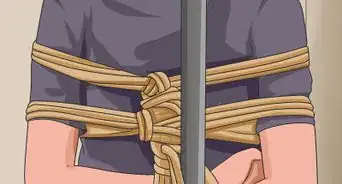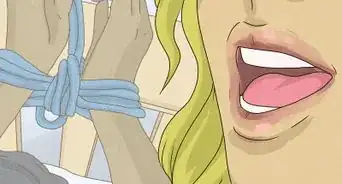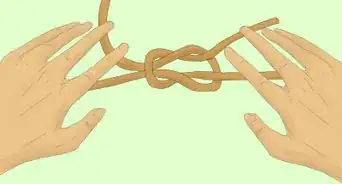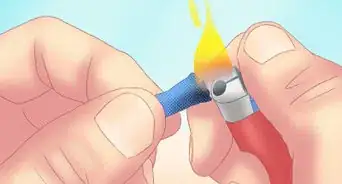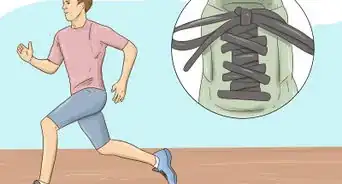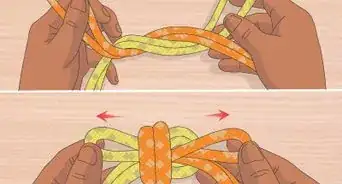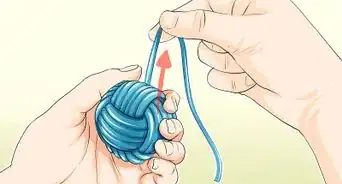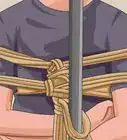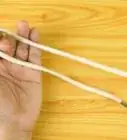This article was co-authored by Britt Edelen. Britt Edelen was an active member of his local Boy Scouts troop near Athens, Georgia from ages 8 to 16. As a Scout, he went on dozens of camping trips, learned and practiced many wilderness survival skills, and spent countless hours appreciating the great outdoors. In addition, Britt worked as a counselor for several summers at an adventure camp in his hometown, which allowed him to share his passion for and knowledge of the outdoors with others.
There are 10 references cited in this article, which can be found at the bottom of the page.
This article has been viewed 80,107 times.
It's easy to create a loop on the end of a thread or line for a loop knot. These types of knots are particularly useful in fishing for attaching the hook to the line. Some common loop knots you can try are the Kreh loop knot, which can keep your line from snagging, and the perfection loop knot, which is an easy, tight knot. The surgeon's loop knot is a great beginner's knot since it relies on movements you likely already know.
Steps
Using a Kreh Loop Knot
-
1Make an overhand knot. Cross the end of the thread back over itself. Leave about 4 inches (10 cm) of thread toward the end of the line. Wrap it around the other side, and then pull the end back towards you through the middle of the loop. Tighten it up until the loop is a bit smaller than a dime.[1]
- This knot is also called the non-slip knot. It's a tight knot, and it doesn't snag on weeds when fishing because the tag end of the line faces down towards the hook.
-
2Thread the hook on if you're using one. If you're using the knot for fishing, push the end of the string through the eye hole in the top of the hook. Pull the hook toward the knot you made earlier.[2]Advertisement
-
3Push the end of the thread back through the loop. Keep the hook between the end of the line and the loop. Thread the end of the line back through the loop and up toward the main, longer part of the line.[3]
- When choosing where to push the thread through, pick the side that's facing slightly downward toward the end of the thread.
-
4Wrap the thread around itself. Moving up the line toward the main part of the thread, take the tail end of the line and wrap it up and around the main part of the line 3-5 times. Turn the end back toward the bottom, and slip it through the loop again.[4]
- This time, push it through the side of the loop that's facing slightly upward toward the rest of the thread.
-
5Tighten and adjust the loop. Pull on the end of the line slightly to tighten it and then add a little bit of water on the main part of the knot so you don't burn the line against itself. Pull on it until the knot tightens up completely, and chop off the end, leaving less than 0.5 inches (1.3 cm).[5]
- To adjust the loop, pull on the end of the thread to make the loop smaller. Pull on the main part of the line to make the loop bigger.
Making a Perfection Loop Knot
-
1Create a simple loop by passing the line behind itself. It's easier to do this loop on a table the first time. Lay the line out, and bring the end of the thread up toward the main part of the line. Pass it underneath the main line, creating a loop.[6]
- You'll need to leave enough room at the end of the line to make another loop, so leave at least 1 to 2 inches (2.5 to 5.1 cm).
-
2Pass the end of the loop back over the top end of the other loop. Pick up the end of the line. Pass it over the main line again, including the top of the loop you just made. Create a second loop by tucking the end underneath the main line. The second loop will overlap the top of the first loop, like scales.[7]
- If you want to add a hook, thread it onto the second loop before you pass the end of the line underneath the main line.
-
3Bring the end of the line between the 2 loops you've made. Cross the end over the main line again, but make it go between the edges of the other loops you've made. The end should come out the other side.[8]
- Be careful not to stab yourself if you've added a hook to the line.
-
4Pull the second loop through the first loop you made. Stick your fingers through the first loop. Grab the edge of the second loop, including the hook. Pull it over the line you just pulled to the other side and out through the large loop.[9]
- The second loop becomes the main loop of the knot.
-
5Tighten the knot. Make sure the hook is where it needs to be. Pull on the end of the line and the loop end until the knot forms. Keep pulling to tighten it up, completing the knot.[10]
Tying a Surgeon's Loop Knot
-
1Pull the end of the line back up toward itself. You're going to double the line on itself to create this knot. Therefore, tug the end of the line back toward the main part of the line.[11]
- Add the hook to the line now, keeping it at the bottom of the loop you just made.
- Be sure to leave at least 4 to 5 inches (10 to 13 cm) to tie the knot.
-
2Make an overhand knot with the doubled line. Keeping the doubled line against itself, wrap the new "end" (which is now a loop) over the line and back around the other side. On the other side, push the end through the circle you've just created and out the other side. Tighten it up slightly.[12]
-
3Wrap the "end" back through the overhand knot again. Take the loop end and wrap it around the back of the overhand knot. Pull it back through the overhand knot a second time. Tighten up the knot.[13]
- The loop you've been using as the "end" of the line now becomes the main loop.
Things You'll Need
- Line or thread
- Fishing hook, optional
- Water, optional
References
- ↑ Britt Edelen. Boy Scout. Expert Interview. 7 February 2020.
- ↑ https://www.youtube.com/watch?v=iv1aNhz7btU&feature=youtu.be&t=43
- ↑ http://www.animatedknots.com/nonslipmono/
- ↑ Britt Edelen. Boy Scout. Expert Interview. 7 February 2020.
- ↑ Britt Edelen. Boy Scout. Expert Interview. 7 February 2020.
- ↑ Britt Edelen. Boy Scout. Expert Interview. 7 February 2020.
- ↑ https://www.youtube.com/watch?v=5x7rgfVzJaw&feature=youtu.be&t=108
- ↑ https://www.animatedknots.com/perfection/index.php
- ↑ https://www.animatedknots.com/perfection/index.php
About This Article
To tie a surgeon’s loop knot, start by taking your line and doubling it back on itself. If you plan on using this knot for fishing, add the hook now! Then, take the doubled-up line and loop it over itself, bringing the end with the hook through the loop and tightening slightly. Finally, bring the hook end back through and pull to tighten the knot ! Keep reading for tips on other types of loop knots you might use for fishing!

